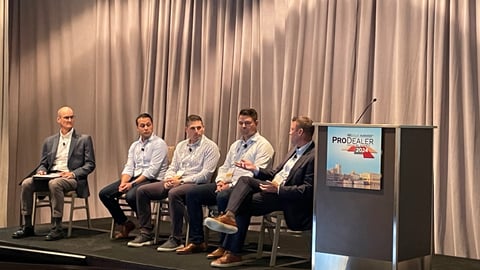Q&A with AZEK’s new digital leader
The world of building materials isn’t necessarily renowned for being on the cutting edge of technology. The AZEK Company, however, is making tech-minded strides and investments to ensure its decking, railing, lighting, trim and siding products remain top of mind for consumers, dealers and contractors alike.
Evidence of that is in the hiring of Rakesh Mohan, who the company recently brought on to helm its digital and tech initiatives. Below, Mohan shares his view of how the company plans to leverage tech tactics to streamline its operations, bolster efficiency and reach a new generation of customers.
Q: What are some of your top objectives during your first few months at AZEK?
Mohan: As AZEK’s new chief digital & technology officer, my priorities will focus on enhancing the customer journey and experience for both B2B and B2C audiences, including dealers, distributors, retailers and homeowners.
By leveraging technology, we aim to create seamless, personalized interactions that make it easier to engage with our products, access information and receive support. For our B2B partners, we’re focused on helping them grow their businesses while being a strong and supportive partner.
Ultimately, our goal is to ensure AZEK is a trusted partner that enhances every step of the customer experience, making doing business easier and more efficient for all of our customers.
Q: What trends do you see shaping the future of decking/outdoor living and the building materials world in general?
Mohan: The building materials industry, particularly in outdoor living, is undergoing a significant transformation, similar to the shift from analog to digital technology. Just as digital tools have revolutionized the way we live and work, composite materials are reshaping outdoor spaces by offering innovative, sustainable and low-maintenance alternatives to traditional wood.
Homeowners and professionals are increasingly turning to composites for their durability, weather resistance and minimal upkeep—much like how digital solutions provide efficiency and convenience. This trend reflects a broader evolution in building materials, where innovation and sustainability are driving the future of outdoor living.
Q: Are there any emerging technologies, platforms or software you feel are overblown and perhaps may decrease in importance?
Mohan: Today, there’s lot of excitement around AI, but it feels somewhat overhyped at the moment. Many companies are struggling to identify meaningful use cases, and as a result, I expect some disillusionment as they don’t immediately see the benefits they hoped for. This follows the typical hype cycle, where we see a peak of inflated expectations followed by a downturn in enthusiasm.
I believe we’ll experience a drop in AI’s perceived importance before companies truly begin to harness its full potential and integrate it in ways that provide real value.
Q: Conversely, which tech will become more essential for building materials companies moving ahead?
Mohan: Looking ahead, the entire suite of digital technologies will become increasingly essential for building materials companies. From e-commerce platforms and data analytics to supply chain management and customer engagement tools, digital solutions will streamline operations, enhance decision-making and improve the overall customer experience.
As the industry continues to evolve, companies that embrace these technologies will be better positioned to meet market demands, optimize efficiency and provide greater value to their customers.
Q: How is the customer journey changing, and how do you foresee it shifting looking ahead?
Mohan: The customer journey is evolving rapidly, especially with the rise of a new generation of consumers who were born into a digital world. They expect every transaction to be digital and mobile-friendly, with minimal steps involved.
Looking ahead, we must adapt to this shift by ensuring that every touchpoint, from product discovery to purchasing and support, is fully digitized and optimized for mobile. No matter what industry we’re in, embracing digital technology is essential to engage and meet the expectations of this next generation of customers.
Q: What guidance would you offer companies that are struggling to get employees and/or customers up to speed on emerging technologies? How do you implement this sort of change for folks who are perhaps skeptical or hesitant to adopt new tech?
Mohan: Helping employees or customers adopt emerging technologies is a common challenge, and in many cases, it’s because we as technologists haven’t done a good enough job communicating the benefits or making it easy for them.
Too often, we fail to clearly explain what’s in it for them or show how the technology can make their lives easier. If we focus on simplifying the experience and providing clear education on how these tools improve efficiency and convenience, adoption will follow.
Think about how Uber or DoorDash transformed entire industries—no one would have imagined getting into a stranger’s car, but because those platforms made life easier, they took off.
Similarly, once people see how emerging technologies can genuinely simplify their work or daily routines, they’ll be much more willing to embrace them.




